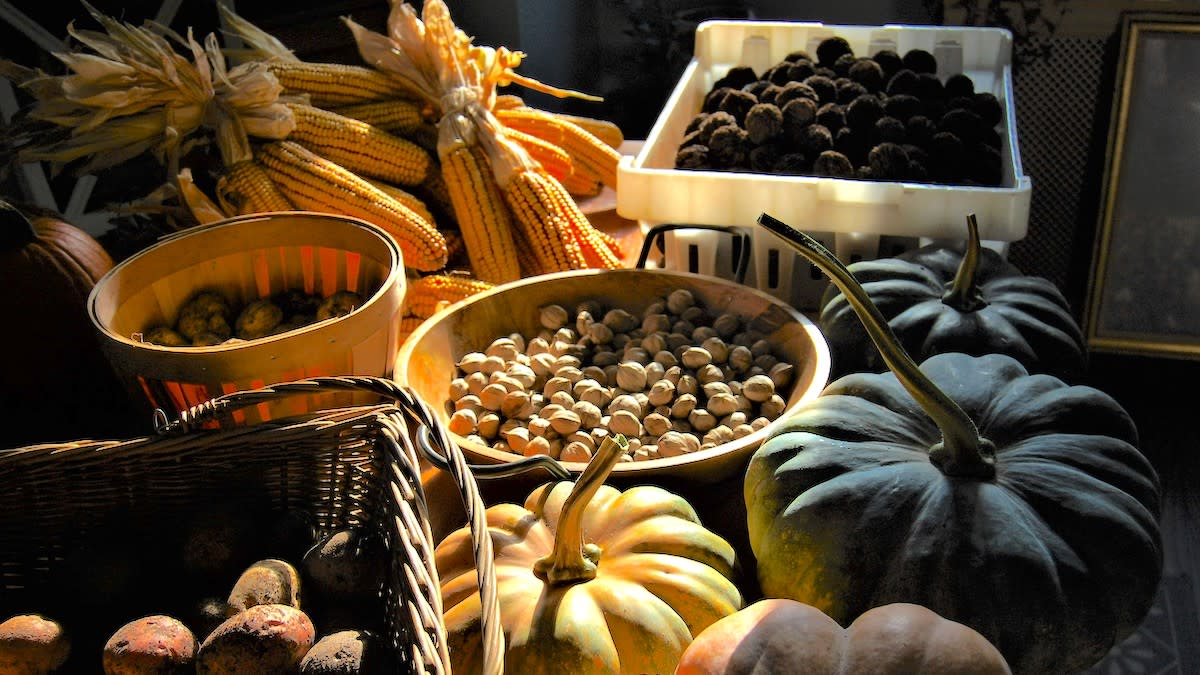
For the past seven years, my wife Silvan and I have been working towards producing as much of our own food as possible. Each fall, we begin a “Living off the Land” challenge where we see how long we can comfortably and healthily go, eating only food that we grew in our gardens or foraged and hunted in the woods. We’ve both been gardening for far longer than seven years, but we mostly grew crops like tomatoes, strawberries, herbs, and other common backyard fruits and veggies before we shifted towards growing food with an emphasis on sustenance.
There are few pleasures in life greater than biting into a juicy, ripe strawberry picked right off the plant, but when it comes to filling your belly, fruits like this tend to fall short. We continue to grow these delicious fruits and veggies, but over the years, we’ve dedicated more and more space to calorie-dense staple crops like potatoes, flour corn, dry beans, and winter squash. These staple crops provide calories, protein, fat, and carbohydrates, and they’re shelf stable at room temperature through the winter.
Planning for Sustenance
Our Living off the Land challenge really begins each spring when we decide which crops to grow and how much space to dedicate to each. Corn, beans, and squash are our primary staple crops through the winter, and they also store the longest in the conditions that our home provides. These crops—known as the Three Sisters—have been used by indigenous people in the Americas for thousands of years, and for good reason. When grown together, the corn provides a tall trellis for the climbing beans, the beans improve the soil by fixing nitrogen from the air in their roots, and the sprawling squash vines smother weeds and retain moisture in the soil.
Grain corn can produce millions of calories per acre when grown this way, so even a small plot is enough to feed a person for months. We typically dedicate about half to three-quarters of our growing space to these staple crops each year.
This past growing season, we grew about 900 square feet of grain corn and harvested 50 pounds dry which is roughly 90,000 calories worth of food—and that’s before factoring in the 150 pounds of pumpkin and 7 pounds of dry beans that we harvested alongside it. To diversify our diet, we grow multiple heirloom varieties of each which leads to beautiful multicolored piles of crops around our home after the fall harvest.
The next crop that we dedicate space to on our planting chart is potatoes. Potatoes are some of the most calorie-dense crops on Earth, and although they don’t store as long as dry corn and beans, they can last well into the winter in the right conditions. We typically grow a number of different potato varieties—both to vary our diet and also to use their variable disease resistance to ensure a good crop from year to year.
Heirloom potato varieties can be blue, red, yellow, or white, and some are even speckled. Many of the pigments that provide these variable colors are bioactive vitamins, so growing a variety helps us diversify our nutrient intake as well. We grow potatoes in our raised beds where the fluffy soil allows them to produce large tubers, and the good drainage prevents too much water from building up and causing fungal issues.
Sustenance in the Kitchen
The Three Sisters provide a balanced habitat in the garden, but of equal importance, they provide the basis for a balanced diet in your body. Together, flour corn and dry beans contain all of the amino acids in a digestible form that your body needs to form proteins. Whole grain corn is also packed with carbohydrates and fat. Pumpkins and winter squash are full of carbohydrates along with vitamins and important nutrients like beta-carotene.
We typically nixtamalize our flour corn which unlocks some nutrients that aren’t bioavailable in raw corn and also improves the flavor. The nixtamalized corn makes delicious tortillas, pupusas, cornbreads, and hush puppies. We like to cook up big pots of beans with a hunk of seared venison shoulder and cubed-up winter squash. Then we pile the beans, venison, and winter squash onto tortillas or cornbread and top it with salsa and cilantro. This meal has my mouth watering as I type, and these calorie-dense crops leave you feeling full and satisfied.
However, none of the crops in the garden stick to your ribs quite like potatoes. Potatoes are excellent as a side dish of French fries, home fries, mashed potatoes, or hash browns. They can even be a meal all on their own—my grandfather used to simply order a plain baked potato with salt when he took us to Wendy’s to get hamburgers.
While eating a plain baked potato might have been a fine meal in my grandfather’s eyes, something tells me that the average person today feels different. If this sounds like torture to you, remember that living off the land isn’t about depriving yourself. Some of the best meals I have ever eaten were comprised of vegetables from our garden, wild foods foraged in the woods, and venison hunted on the public land around us. Living off the land is about growing the foods that make you feel satisfied and fed and that varies from family to family.
This past winter, Silvan and I comfortably went three months living off the land, and it was one of the most rewarding experiences of my life. We ate delicious, hearty meals every day, experimented with new flavors, and learned from that experience how we want to adjust and improve our garden plan for this upcoming season. Although we haven’t yet put a seed in the ground, I’m already looking forward to our next challenge this fall.









